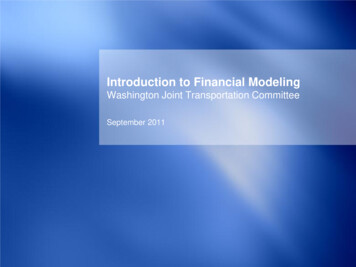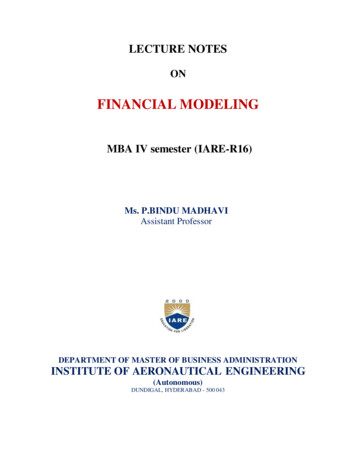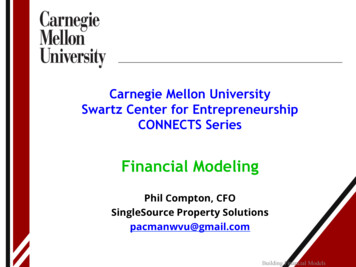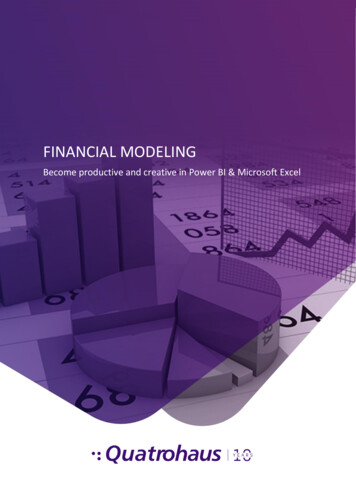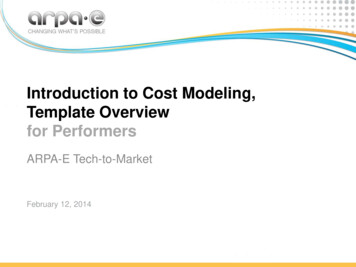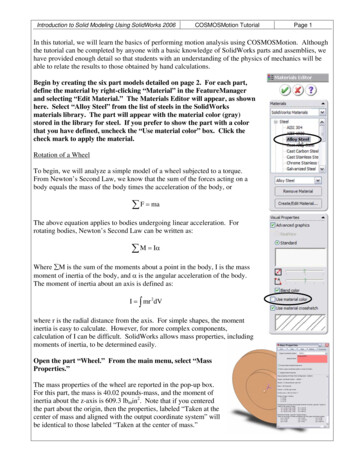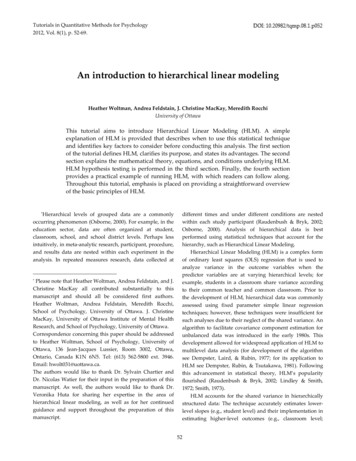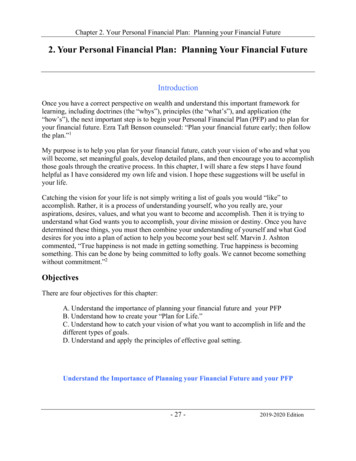
Transcription
Financial ModelingAn introduction to financial modelling and financial optionsConall O’SullivanBanking and FinanceUCD Smurfit School of Business31 May / UCD Maths Summer School
OutlineIntroductionFinancial ModelingBasics of Financial ModelingDerivatives
OutlineIntroductionFinancial ModelingBasics of Financial ModelingDerivatives
A Quick Look at BubblesThe Tulip Crash Netherlands, 1634-1637 Tulips were brought from Turkey to the Netherlands in1593. After some time tulips contracted a nonfatal viruscalled mosaic, which did not kill the population but causedflames of colours. This made the flower unique.
A Quick Look at BubblesThe Tulip Crash Netherlands, 1634-1637 Tulips were brought from Turkey to the Netherlands in1593. After some time tulips contracted a nonfatal viruscalled mosaic, which did not kill the population but causedflames of colours. This made the flower unique. Thus, tulips began to rise in price. Everyone began to dealin bulbs, essentially speculating on the tulip market.
A Quick Look at BubblesThe Tulip Crash Netherlands, 1634-1637 Tulips were brought from Turkey to the Netherlands in1593. After some time tulips contracted a nonfatal viruscalled mosaic, which did not kill the population but causedflames of colours. This made the flower unique. Thus, tulips began to rise in price. Everyone began to dealin bulbs, essentially speculating on the tulip market. The true bulb buyers filled up their inventories, soincreasing scarcity and demand.
A Quick Look at BubblesThe Tulip Crash Netherlands, 1634-1637 Tulips were brought from Turkey to the Netherlands in1593. After some time tulips contracted a nonfatal viruscalled mosaic, which did not kill the population but causedflames of colours. This made the flower unique. Thus, tulips began to rise in price. Everyone began to dealin bulbs, essentially speculating on the tulip market. The true bulb buyers filled up their inventories, soincreasing scarcity and demand. Soon prices were rising so fast and high that people weretrading their land, life savings to get more tulip bulbs.
A Quick Look at BubblesThe Tulip Crash Netherlands, 1634-1637 Tulips were brought from Turkey to the Netherlands in1593. After some time tulips contracted a nonfatal viruscalled mosaic, which did not kill the population but causedflames of colours. This made the flower unique. Thus, tulips began to rise in price. Everyone began to dealin bulbs, essentially speculating on the tulip market. The true bulb buyers filled up their inventories, soincreasing scarcity and demand. Soon prices were rising so fast and high that people weretrading their land, life savings to get more tulip bulbs. The originally overpriced tulips enjoyed a twenty-foldincrease in value - in one month.
The Tulip Crash Netherlands, 1634-1637 The prices were not an accurate reflection of the value of atulip bulb.
The Tulip Crash Netherlands, 1634-1637 The prices were not an accurate reflection of the value of atulip bulb. This is called a speculative bubble, and typically somepeople decided to sell and crystallize their profits.
The Tulip Crash Netherlands, 1634-1637 The prices were not an accurate reflection of the value of atulip bulb. This is called a speculative bubble, and typically somepeople decided to sell and crystallize their profits. A domino effect of progressively lower prices took place,as everyone tried to sell while not many were buying.
The Tulip Crash Netherlands, 1634-1637 The prices were not an accurate reflection of the value of atulip bulb. This is called a speculative bubble, and typically somepeople decided to sell and crystallize their profits. A domino effect of progressively lower prices took place,as everyone tried to sell while not many were buying. Dealers refused to honour contracts and people began torealize that they traded their homes for some bulbs.
The Tulip Crash Netherlands, 1634-1637 The prices were not an accurate reflection of the value of atulip bulb. This is called a speculative bubble, and typically somepeople decided to sell and crystallize their profits. A domino effect of progressively lower prices took place,as everyone tried to sell while not many were buying. Dealers refused to honour contracts and people began torealize that they traded their homes for some bulbs. The government attempted to step in and halt the panicand the crash, but that did not work out well.
The Tulip Crash Netherlands, 1634-1637 The prices were not an accurate reflection of the value of atulip bulb. This is called a speculative bubble, and typically somepeople decided to sell and crystallize their profits. A domino effect of progressively lower prices took place,as everyone tried to sell while not many were buying. Dealers refused to honour contracts and people began torealize that they traded their homes for some bulbs. The government attempted to step in and halt the panicand the crash, but that did not work out well. Even the people who locked in their profit early sufferedunder the following depression.
OutlineIntroductionFinancial ModelingBasics of Financial ModelingDerivatives
Interest RatesSafe MoneyThe simplest concept in finance is the time value of money. 1 today is worth more than 1 in a year’s time.There are several types of interest There is simple and compound interest. Simple interest iswhen the interest you receive is based only on the amountyou initially invest, whereas compound interest is when youalso get interest on your interest.Interest typically comes in two forms, discretelycompounded and continuously compounded.Invest 1 in a bank at a discrete interest rate of r (assumedto be constant), paid once per year.At the end of one year your bank account will contain1 (1 r ).
Interest Rates Now suppose you receive m interest payments at a rate ofrm per annum. After one year you will have (1 Suppose these interest payments come at increasinglyfrequent intervals, but at an increasingly smaller interestrate (we will take the limit m ). This will give acontinuously paid rate of interest. The expression above becomes(1 r mm) .r m) em log(1 r /m) ermThat is how much money you will have in the bank afterone year if the interest is continuously compounded.And similarly, after a time t you will have an amount ert .
Interest Rates Suppose M(t) in the bank at time t, how much does thisincrease with time?If you check your account at time t and again a shortperiod later, time t dt, the amount will have increased byM(t dt) M(t) dM dt . . . (Taylor series expansion).dtThe interest you receive must be proportional to theamount you have, M, the interest rate r and the time-step,dt. Thus,dMdMdt rM(t)dt rM(t).dtdt If you have M(0) initially, then the solution isM(t) M(0)ert .Conversely, if you know you will get 1 at time T in thefuture, its value at an earlier time t is simply e r (T t) .
Financial InstrumentsEquitiesA basic financial instrument often referred to as equity, stock orshares. This is the ownership of a small piece of a company. The price is determined by the value of the company andby the expectations of the performance of the company. These expectations are seen in the bid and ask behaviourin the market. The expectations give an uncertainty to the future pricedevelopment of the stock. The exact profit is known only at the date of selling. The real value of the stock is sometimes a bit higher,sometimes a bit lower than the expected value. The amount in which the stock price development candiffer from the expected value is determined by theso-called volatility.
VolatilityWhat does it mean? A statistical measure of the tendency of a market orsecurity price to rise or fall sharply within a period of time.Volatility is typically calculated by using variance of theprice or return. A highly volatile market means that priceshave huge swings in very short periods of time. Security: An instrument representing ownership (stocks), adebt agreement (bonds), or the rights to ownership(derivatives). Return: The gain or loss of a security in a particular period.The return consists of the income and the capital gainsrelative on an investment. It is usually quoted as apercentage.
VolatilityFigure: Volatility
ExchangesShares of larger companies are quoted on regulated stockexchanges, so that they can be bought and sold freely.Figure: London Stock Exchange
Security Prices Prices have a large element of randomness. This does notmean that we cannot model stock prices, but it does meanthat the modelling must be done in a probabilistic sense. A well known and often used model for generating assetprices via a stochastic differential equation is referred to asgeometric Brownian motion.Figure: FTSE 100 Stock Index Over Last 30 ep98Feb04Aug09Feb15
FTSE 100 The graphs below depicts the FTSE over the course of asingle trading day (11/05/2004)!Figure: FTSE 100 Stock 24:0015:36:0016:48:0018:00:00
Modeling Asset Prices When investing, the main concern is that the return on theinvestment is satisfactory. Suppose we have given asset St, thenSt δt StStock tomorrow - Stock today Return Stock todayStLets see this in practise. Below is the returns of the FTSE100 over last 30 years.0.10.050 0.05 0.1 0.15Mar82Sep87Mar93Sep98Feb04Aug09Feb15Figure: FTSE 100 Stock Index Returns
Modeling Asset Prices From the data in this example we find that the mean is0.00028543 (0.0285%) and the standard deviation is0.0121 (1.21%).1400120010008006004002000 0.2 0.15 0.1 0.0500.050.10.15Figure: FTSE 100 Histogram
Randomness of the stock pricesDaily returns for assets look like noise! What can be then done? We can model the noise! Definition: Wiener Process:A stochastic process Wt for t [0, ) is called a WienerProcess (or Brownian motion) if the following conditionsare satisfied: It starts at zero: W0 0,It has stationary, independent increments,For every t 0, Wt has a normal distribution with mean 0and variance t,It has a.s. continuous paths with NO JUMPS.
Weiner Processes A sample of trajectories from a Weiner process3.532.521.510.50 0.5Mar82Sep87Mar93Sep98Feb04Aug09Figure: FTSE 100: SimulationsFeb15
Weiner Processes A sample of trajectories from a Weiner process (real FTSEhighlighted)3.532.521.510.50 0.5Mar82Sep87Mar93Sep98Feb04Aug09Figure: FTSE 100: SimulationsFeb15
Stochastic ProcessesSuppose we observe the stock price of Company Y at everyfixed instance t from some initial time t0 till today tn and wedenote T [t0 , tn ]. We can interpret the observed stock values as a realisationXt (ω) of the random variable Xt . We need a model which takes into account almostcontinuous realisations of the stock prices. Definition: Stochastic ProcessA stochastic process Xt is a collection of random variables(Xt , t T ) (Xt (ω), t T , ω Ω)
Stochastic ProcessesWe note that a stochastic process Xt is a function of twovariables: for a fixed time t it’s a variable Xt Xt (ω), ω Ω for a fixed random outcome ω Ω, it’s a function of timeXt Xt (ω), t T
Modeling Asset PricesThe most popular Stochastic Process for generating prices isthe Geometric Brownian Motion process (GBM):dSt µSt dt σSt dWt ,which can be translated to:St δt St µδt σ(Wt δt Wt )Stwhere µδt is the deterministic return σdWt is the random change with dWt a sample from anormal distribution with mean 0 and variance δt.
OutlineIntroductionFinancial ModelingBasics of Financial ModelingDerivatives
Derivatives It was only on 26th April 1973 that options were firstofficially traded on an exchange. It was then that TheChicago Board Options Exchange (CBOE) first createdstandardised, listed options. Initially there were just calls on 16 stocks. Puts weren’tintroduced until 1977. In the US options are traded on CBOE, the AmericanStock Exchange, the Pacific Stock Exchange and thePhiladelphia Stock Exchange. Worldwide, there are over 50 exchanges on which optionsare traded.
DerivativesOptionIs a contract written by a seller, that gives the right (but not theobligation) to the holder to trade the underlying asset in thefuture at a previously agreed price.Option styles: European option- an option that may be only exercised onexpiration; American option - an option that may be exercised on anytrading day (also on the expiration); Barrier option - option which is exercised, for example, onlyif security’s price reaches some trigger level during the lifeof the option.
DerivativesMost popular options are Call and Put options: At a prescribedtime in the future, (maturity: T): Call Option: The holder of the option may purchase aprescribed asset (shares, stocks : S) for a prescribedamount (strike: K ) and the writer of the contract must sellthe asset, if the holder decides to buy it. Put Option: The holder of the option may sell a prescribedasset (shares, stocks : S) for a prescribed amount (strike:K) and the writer of the contract must buy the asset, if theholder decides to sell it.
Option Payoffs The value of European call option at expiry T is given by:C(T , ST ) max(ST K , 0) The value of European put option at expiry T is given by:P(T , ST ) max(K ST , 0)
Option Payoffs
Option Payoffs
Option Payoffs
Option Payoffs
Valuing OptionsWhat determines the value of an option? what is the asset price today St ? how long there is until expiry T t? how volatile is the asset St ?General principles: The longer the time to expiry, the more time there is for theasset to rise or fall; The more the asset is volatile the higher the chance that itwill rise or fall;
Valuing OptionsFor K 100 which call option is more expensiveCA CB , CA CB , CA CB ? To find the answer we follow thereasoning of replicat
Financial Modeling An introduction to financial modelling and financial options Conall O’Sullivan Banking and Finance UCD Smurfit School of Business 31 May / UCD Maths Summer School. Outline Introduction Financial Modeling Basics of Financial Modeling Derivatives. Outline Introduction Financial Modeling Basics of Financial Modeling Derivatives. A Quick Look at Bubbles The Tulip Crash .File Size: 1MBPage Count: 57
